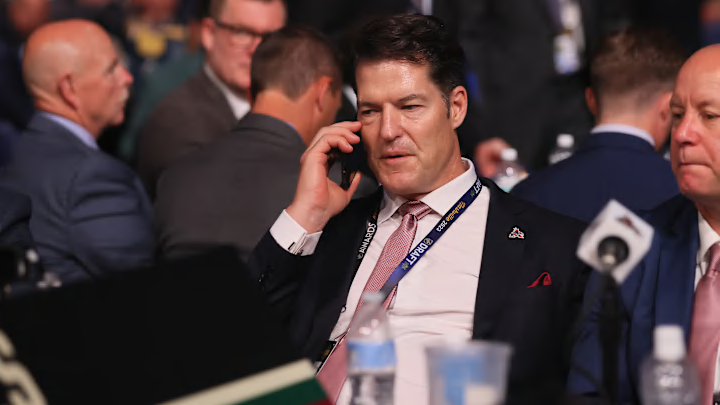Ever since the ball dropped and 2023 became 2024, things have been less than ideal for the Arizona Coyotes. The club entered the year with a three-point cushion on the Edmonton Oilers, Seattle Kraken and St. Louis Blues for the second wild card spot. Since then, however, they've gone 4-9-1, including their current four-game losing streak, to fall five points out. Throw in another wave of uncertainty around the future of the franchise, and it hasn't been a great start to the year.
With less than a month to go before the March 8 trade deadline, this slide could have significant implications on GM Bill Armstrong's approach in the coming weeks. As the backslide continues, more focus could be placed on finding homes for pending unrestricted free agent veterans like Jason Zucker and Matt Dumba.
Not so fast, though. The past few weeks haven't erased what was an unexpectedly strong start for the Coyotes, nor have they taken the team completely out of contention for what would be just their second playoff appearance since 2012. Here's why Armstrong and the 'Yotes should look to be buyers instead of sellers ahead of March 8:
They're Getting Healthy
Thursday's solid effort against the defending champion Vegas Golden Knights might have resulted in a tough 3-2 loss, but at least some hope arrived in the form of three players who returned from injury. Barrett Hayton (upper-body injury) was back in the lineup for the first time since mid-November, while Dumba (upper-body injury) and Travis Dermott (lower-body injury) returned from their own injury-related absences.

Additional help up front and on the back end can only be a good thing heading into a critical stretch for Arizona. Hayton, in particular, could offer a significant boost if he can return to the 2022-23 form that saw him score a career-best 19 goals and 43 points. Add another piece or two to that group, and suddenly you have a roster to rival most of the wild card competition in the Western Conference.
The Roster is About to Get Expensive
On one hand, it seems like the Coyotes' core is just coming into their own and set to grow together. After all, the club ranks among the league's youngest and franchise cornerstones like Clayton Keller and Lawton Crouse are signed long-tem.
Standing in the way, however, is the looming cost of keeping the group together. This summer, a whopping 15 players will have their contracts come up (13 if you exclude the stashed contracts of Jakub Voracek and Bryan Little), including the entire blue line. Among the restricted free agents, Hayton will likely be due a raise, as will defensive stalwarts Sean Durzi and J.J. Moser.

Rising costs, which certainly can affect a franchise like the Coyotes more than others, will make roster decisions that much tougher in the years to come. For the front office, it may be worth taking advantage of the current cost-controlled group while they can.
Plenty of Future Assets
While it's true that you can never have too many skilled prospects in your system, there comes a point where there are other ways to weaponize that system. Some hockey sites have Arizona's prospect pool ranked as high as seventh in the league, with names like Conor Geekie, Victor Söderstrom and Dmitri Simashev on the rise. That doesn't even include a young foundational core at the NHL level that includes the likes of Keller (25), Hayton (23), Durzi (25), Moser (23), Matias Maccellli (23), Dylan Guenther (20) and Logan Cooley (19).

Then you have the small bounty of future draft picks owned by the Coyotes, including up to 13 in the upcoming 2024 draft. Between the draft and prospect capital, there are plenty of future assets available to entice other organizations while also holding onto plenty of blossoming talent for the years to come. An impact veteran or two, however, would be far less of a plentiful commodity.
Any trades with an aim of immediate contention would certainly carry plenty of risk. Not only does Arizona sit five points off the pace of a playoff spot, but they have to leapfrog the Nashville Predators, Calgary Flames, Minnesota Wild and Kraken just to catch the Blues for that final wild card spot. However, few teams are better positioned to make such a push in terms of assets and cap space. There's no sense in building for tomorrow when, for the Coyotes, tomorrow seems awfully uncertain.
